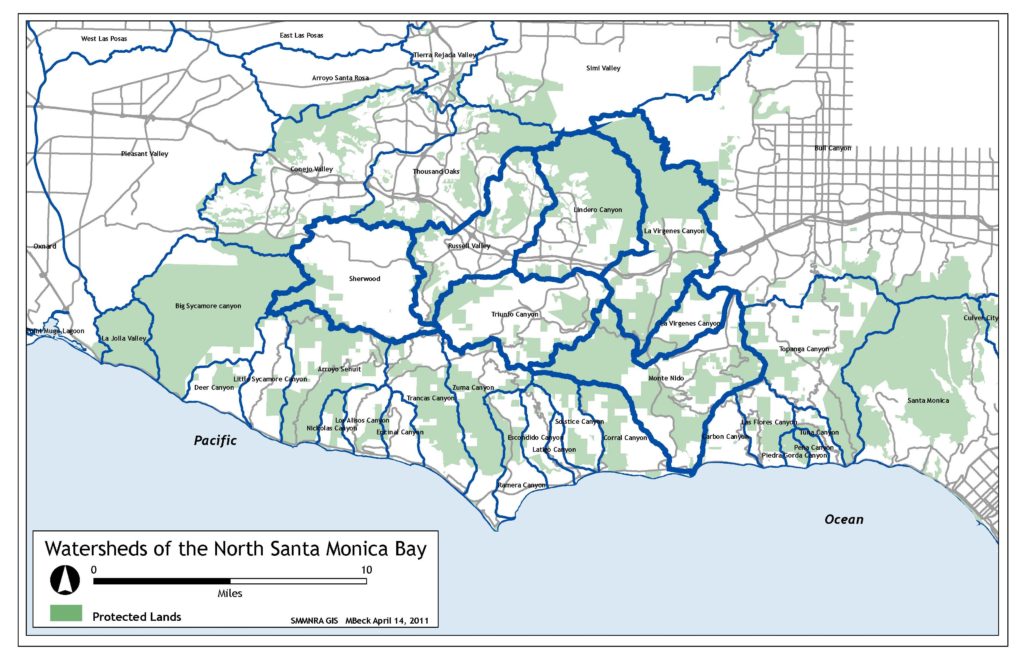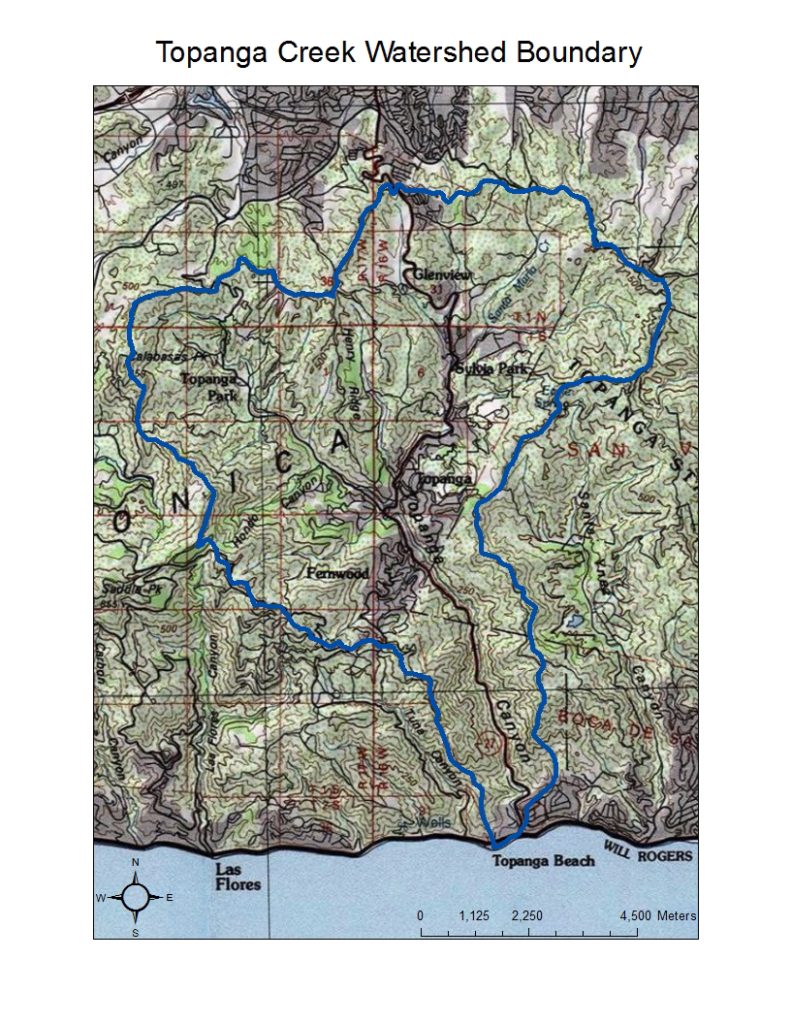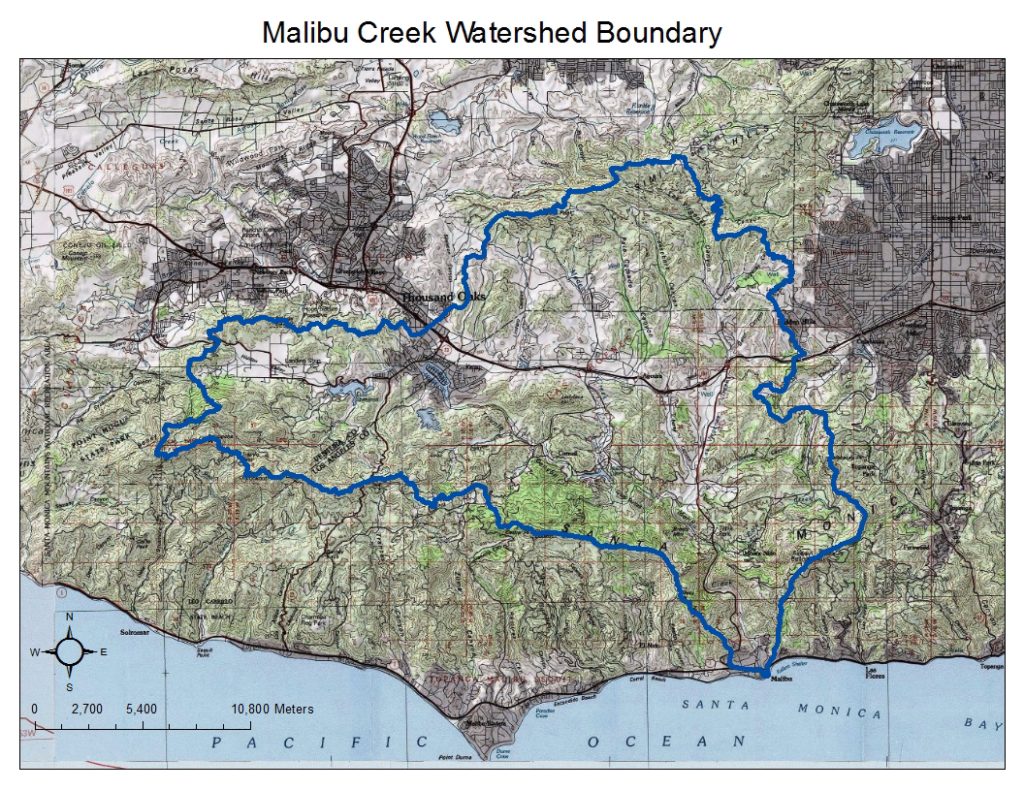What is a watershed?
A watershed is a geographic area that collects all the rainfall into a series of drainages and creeks, eventually reaching the sea. The water that runs off every roof, every driveway, and every road eventually finds its way into a shared waterway. Our largest watershed that drains into the Santa Monica Bay is Ballona Creek (130 square miles) and the second largest is Malibu Creek (109 square miles). At 18 square miles (12,800 acres), Topanga Creek is the third largest drainage into the Santa Monica Bay.
Watersheds of North Santa Monica Bay
The watersheds of North Santa Monica Bay include Malibu Creek and Topanga Creek, as well at the more rural drainages of Arroyo Sequit, Big Sycamore, Las Flores, Solstice, Zuma, and Trancas canyons. These watersheds are largely undeveloped, with much of the land area protected by Santa Monica Mountains NRA, California State Parks, and other land conservation organizations.

Topanga Creek Watershed
Think about the community we call Topanga. It is the creek that defines the community on many levels, from placement of the homes, utilities and roads (along the floodplain), to how natural disasters like wildfires and floods impact our lives. The center of town is where the main stems of the creek meet from Old Topanga and along Topanga Canyon Blvd. from the top of Topanga. Most of the creek banks are held in place by native trees and plants, creating a beautiful landscape. The life of the creek is punctuated with catastrophic events that can change it dramatically.
Topanga Creek has the greatest diversity of native plants and animals found in any watershed in the Santa Monica Mountains. From endangered steelhead trout and rare western pond turtles, to the majestic coast live oaks and CA sycamores that frame the creek, the community of Topanga extends a welcome to over 22 amphibian and reptile species, 3 species of native fish, 9 species of bats, numerous rare mammals like ringtail cats and badgers, as well as over 100 resident and migratory birds.
Unlike other nearby creeks, only small, isolated populations of exotic animals like crayfish and bullfrogs are found. While invasive plants like Giant Bamboo (Arundo) and Cape Ivy are a problem, they have not yet overwhelmed the natural vegetation. That is why education is so critical. If all residents of the watershed learn about how their actions can make a real difference, then together we can find the path to living in harmony with our watershed.

Malibu Creek Watershed
At 109 square miles, the Malibu Creek Watershed is one of the largest discrete watersheds draining into Santa Monica Bay, second only to the Ballona Creek Watershed. Malibu Creek and its tributaries reach east into Ventura County, winding through the Santa Monica Mountains and neighborhoods like yours until eventually reaching Santa Monica Bay.
Over 90,000 human residents in five cities and unincorporated areas of Los Angeles County call this watershed home, as do countless plant and animal species. Some animal species, such as the steelhead trout, tidewater goby and brown pelican are endangered. Many others, such as the snowy plover and peregrine falcon, are threatened. The watershed also hosts the popular Malibu Creek State Park, many hiking/biking trails, and spectacular scenery spanning from the ocean to the mountains.
Protecting this watershed is important not only for residential quality of life, but also to ensure the long-term health of the ecosystem. However, increased urbanization has resulted in water quality and quantity issues, as well as loss of critical habitat. Collectively, our actions can either harm or help this amazing place we call home. By taking responsibility for ensuring the overall health of the watershed and minimizing actions that adversely impact our natural resources, we can assure its viability for future generations.

Living Lightly in the Santa Monica Mountains
This website provides local residents with pages of useful information to help make watershed protection and preservation easier than ever. Not only will you find information on the watershed’s many natural resources, you will also find great tips and information on how to improve your immediate environment – and even save money in the process. From recycling center locations and public transportation/commuting alternatives to landscaping tips and green building resources, you will find plenty of information on how to Live Lightly in our Watersheds. Enjoy!
